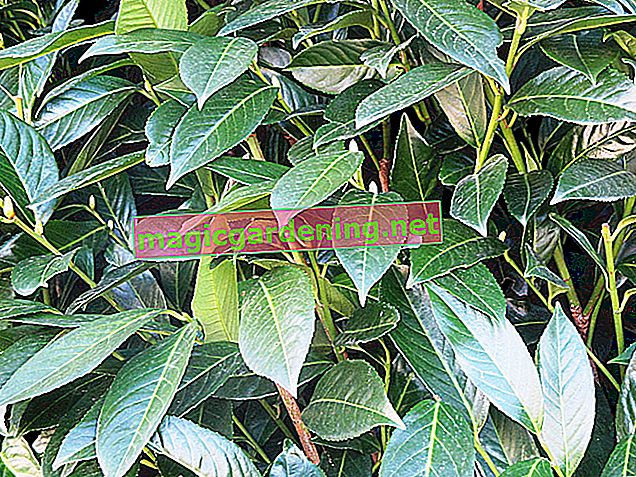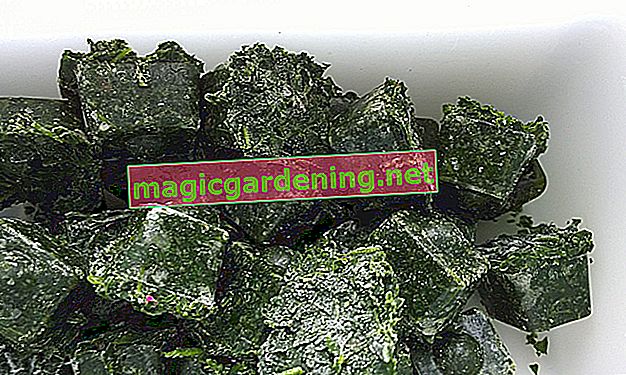
Flowering on annual long shoots - what does that mean?
Almond trees are among the classic spring bloomers that carry their valuable blossom wood on a stable framework. Cultivated as a magnificent shrub, the basic structure reaches a height of 150 to 200 centimeters. Creative home gardeners are happy to raise the Asian ornamental wood as a picturesque tall trunk or acquire it ready-made from the hand of the master gardener in a tree nursery or garden center. The pale pink flower clusters unfold most beautifully on annual long shoots . The more of these short-lived shoots appear on the bush and tree crown, the more opulent the abundance of flowers.
also read
- How to cut berry bushes correctly - tutorial with instructions
- How to cut clematis correctly - a tutorial
- How to cut ornamental grasses correctly - instructions in the tutorial
For a competent pruning, the question arises how the growth of annual long shoots can be promoted. A short excursion into the different types of drives brings light into the darkness. This is how you recognize and promote the young blossom wood on almond trees:
- Long shoots are at least 15 to 20 centimeters long, often significantly longer
- Growth in summer with a synchronous arrangement of flower buds
- Recognizable as unbranched side shoots on supporting scaffold shoots
- The flower buds unfold in April
As the illustration below shows, annual shoots can be recognized by the fact that they only branch out in later years. Once annual long shoots have borne flowers on the almond tree, they quickly age. It is therefore an advantage if you cut back the faded, annual shoots after the flowering period . In this way you will make room for young shoots that will grow in length over the course of summer and create numerous buds for the next flowering period.



Types of cut and date
The pivotal point for correct pruning are the annual long shoots as the most precious blossom wood. Closely related to this is a stable framework that allows the young shoots to sprout on the bush and crown every year. Based on this knowledge, the following types of cuts are available to elicit its most beautiful spring blossom from an almond tree:
| Cut type | Goal / occasion | best date |
|---|---|---|
| Parenting shrub | stable framework for short-lived blossom wood | during the first 4 to 5 years in May |
| Parenting cut Hochstämmchen | Structure of trunk and harmonious crown | in May to the desired stem height and finished crown |
| Conservation cut shrub and crown | promote young blossom wood | annually after the flowering period |
| Rejuvenating cut shrub | Revitalize aging shrub | Late winter |
When planning the schedule, it is noticeable that May is the best time for parenting and maintenance cuts. At this stage, your almond tree has not yet started to plant fresh long shoots with new flower buds. The only exception is for a taper cut. As the instructions below make clear, the tapering is associated with a radical cut. An almond tree can cope better with the procedure during the winter sap dormancy. Furthermore, with a cut time in winter, you act in accordance with the law. The Federal Nature Conservation Act stipulates that you may only radically prune trees between October 1st and February 28th. The grace period extends from March 1st to September 30th at the same time as the breeding business of our feathered friends.An exception applies to light maintenance cuts, which are limited to the current increase.
Raising almond trees into shrubs
Almond trees show themselves from their most beautiful side as well-formed shrubs with a framework of three to five ground shoots . In the first four to five years, pruning focuses on the upbringing of selected ground shoots. Instead of just letting it grow, we recommend building it up gradually with an increase of around 10 centimeters per year. This has the advantage that after each cutting stage a juice jam occurs, which leads to vital and dense branching. How to achieve the perfect parenting style:
- Pick three to five of the most promising ground shoots
- Consistently cut off all other ground shoots at the base
- After the flowering period, cut back last year's growth to about 10 centimeters
- Shorten the side branches along the bottom shoots to 3 to 4 buds
It is not possible to specifically forecast the period over which the shrub training will extend. The annual increase in almond trees varies between 20 and 70 centimeters, depending on the local site conditions. Furthermore, the duration depends on the desired final height. Lateral long shoots with numerous flower buds already thrive during training. As illustrated in the figure below, severely pruned the dead branches while lengthening the ground shoots a little more generously by 10 centimeters.

Raising tall trunks - this is how it works
In the small garden and tub or as a floral reception committee in the front garden, almond trees shine in the form of decorative tall trunks. For the knowledgeable home gardener, it is a matter of honor to raise an almond tree on their own. How to do it right:
- Choose the strongest ground shoot for the future trunk
- Put a support post in the ground next to the ground shoot to connect the two
- Cut off all remaining ground shoots at the base
- Guide the central shoot up the rod in 10-centimeter steps to the desired trunk height
- Remove bottom and side shoots regularly
A well-formed crown consists of a central shoot as a trunk, a trunk extension and four to five side shoots as leading branches, as shown in the figure below. The branching to the crown starts when you cut off the tip of the central shoot. Please only make this cut when the tip bud is four to five buds above the desired crown base. First wait for the next shoot to select the best leading branches. Cut all other branches vertically just before the trunk bark. Nose-wise ground shoots that sprout as vertical competition to the trunk are cut off at the base.

background
Removal of the tip bud activates crown branching
The upbringing of almond trees as high trunks benefits from a dominance of the top bud. In the growth law of peak funding it is anchored that the strongest growth develops from the top bud of the central shoot. Significantly less growth occurs on buds positioned lower along the future high stem. Conversely, this means that when you remove the top bud, you start the branching to the crown. Immediately after the tip of the shoots has been cut, the sap pressure is distributed among the previously subordinate shoot buds, which then sprout vigorously and are built up into leading branches.Preservation cut - step-by-step instructions
If the upbringing leaves a magnificent almond tree as a shrub or high trunk, the pruning leads to an annual maintenance. The best time is immediately after the flowering period has ended. The focus is on all withered shoots that have so far been completely exhausted and are vigorously cut back. The growth on the shrub structure or the crown-leading branches can also be reduced. This is how the maintenance cut runs in detail:
- Vigorously cut back shoots with withered flowers down to 3 or 4 buds
- Remove dead and inward branches
- Shorten scaffold drives or guide branches that are too long to the required length
For a flawless cut, please apply the scissors just above an outward-facing bud or an alternate leaf. Please do not leave long stubs longer than 5 millimeters. The residual wood dries or rots back, which is a good target for diseases and pests.
Digression
Outdated scaffolding shoots slim down with a derivation cut
Scaffold shoots on the almond tree reliably subsidize the growth of side shoots as blossom wood for many years. Heavily branched heads on individual main branches do not mean that you have to remove the supporting branch from the shrub or crown. By sliming down an aged point, a scaffold drive continues to fulfill its load-bearing function. Slimming is easy and uncomplicated with a derivation cut. For this purpose, look for a vital side shoot further inside the scaffold shoot. Where the aged leading branch and young shoot fork, cut off the old wood. Ideally, move the point of intersection a few millimeters behind the fork so that you do not damage the young wood.Rejuvenate old almond trees
Three years without a maintenance pruning are enough for an almond tree to grow old and rotten to blossom. To make matters worse, overaged long shoots are prone to the dreaded Monilia peak drought. There are several reasons to give the flowering shrub a radical makeover. This is how the plan works:
- The best time is in late winter until the end of February when the weather is frost-free
- Thoroughly examine the wood for feathered or fur-bearing winter guests and postpone the appointment if necessary
- Cut old, aged scaffold shoots back to 10 to 20 centimeters
- Alternately, use young ground shoots as a new framework
- Cut the side branches along the new scaffold shoots to three buds
- Fertilize the rejuvenated almond tree with 3 liters of compost and 150 grams of horn shavings
It is an advantage if you derive a disused ground instinct instead of radically eliminating it. Before removing a candidate, examine the lower shoot for an auspicious, outward-facing side shoot. Where old and young wood branch out, place the scissors or saw a few millimeters behind the fork.
Do not seal cuts
Does the rejuvenation cut leave one or the other larger cut? Then please do not use tree wax (€ 5.99 at Amazon *) or similar wound sealants. Well-founded research and field tests on all aspects of wound healing on woody plants have shown that an airtight coating of cut wounds does more harm than good. The preparations prevent the plant's own wound wood from fulfilling its duties.
It is completely sufficient if you smooth out cuts with a knife and leave the rest to the almond tree. An exception applies if heavy frost is to be expected after the cut. In this case, coat the wound edges thinly with tree wax to protect the exposed cambium.
frequently asked Questions
Is the almond tree poisonous?
The almond tree (Prunus triloba) inspires in our regions with its picturesque spring blossom and does not bear any fruit. Shoots, leaves, roots or bark do not contain any toxic substances. However, caution is advised with the almond tree. The bitter almond (Prunus dulcis var. Amara) in particular bears highly poisonous fruits, which, however, rarely ripen in our regions.
I have heard that the almond tree is prone to Monilia peak drought. What can I do preventively against this plant disease?
Monilia pathogens are spread via the air and enter the interior of the plant via the flowers. For this reason, you should prune the almond trees vigorously every year after the flowering period. At the same time, this is the best time for a balanced supply of nutrients, because the sapling will subsequently form new shoots that will bear flowers in the next year.
I did not cut my almond tree after flowering. Now the crown has grown very large. Although the tree is only two years old, it has already reached a height of 4 meters. Can I still cut in late summer?
In late summer, an almond tree has already planted the flower buds for the next year. We recommend that you limit the pruning to a third of the length of the shoot. If you cut deeper, the flower festival will be canceled completely next spring.
I would like to plant an almond tree in a bed about 80 centimeters wide. A 40 centimeter high drywall forms the border of the bed. Can it happen that the tree with its roots will damage the wall at some point?
The almond tree Prunus triloba is characterized by weak growth. Since the tree is strictly cut back regularly after the flowering period, no noticeably strong roots can develop. The risk of damaging the drywall is minimal.
The 3 most common mistakes
A tired almond tree with few flowers and many aged shoots is a shadow of itself. So that you don't have to struggle with a depleted, rotten shrub or tall trunk, the following table draws attention to the three most common cutting errors that are responsible for the floral dilemma:
| Cutting errors | Damage | prevention |
|---|---|---|
| never cut | dense network of old, heavily branched scaffolding and long shoots | After each flowering period, cut back long shoots of the previous year |
| wrong cutting time | Failure of the flowering period | Cut immediately after flowering |
| Central shoots cut off too early when raising the trunk | measly tall trunk | Do not cut the tip bud too early |
Tips
In the bucket, the almond tree transforms the balcony and terrace into a pink and white spring fairy tale. However, the small beauty in potted cultivation is nowhere near as hardy as it is when planted in the bed. Stop the nutrient supply by the end of July at the latest so that the shoots mature. Wrap the bucket with foil or fleece and place it on wood. In the event of late frosts, wrap the crown with breathable fleece so that the tender buds are not damaged.








